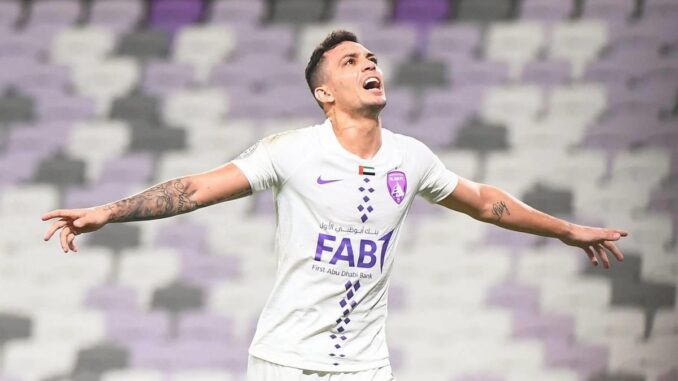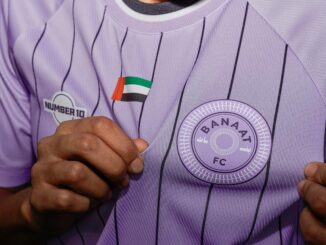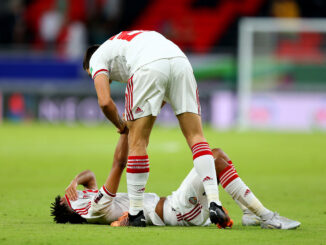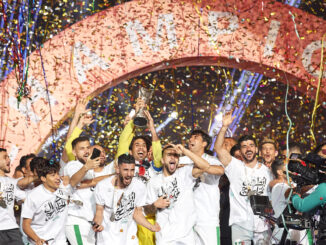
For long, the UAE resisted.
Then, in January 2020, the UAE Football Association declared that two South American players had become eligible to play for the country’s national team.
And not just any two South Americans. Given the Emirati citizenship were Al Ain’s Brazilian, Caio Canedo, and Al Wahda’s Argentine Sebastian Tagliabué, two players who between them have variously lit up the Arabian Gulf League over the last decade.
For Canedo, who at 29 is six years Tagliabué’s junior, this is a tantalising prospect in particular.
Could he be the man to drag the UAE national team out of its current rut?
With football at a standstill in the UAE and around the world during the coronavirus crisis, the answer might have to wait a little longer.
But debate over the rights and wrongs of the move is certainly under way.
When the news was announced at the start of the year, some UAE media outlets, with some degree of understatement, highlighted that the decision will open up an extra spot for a foreign player in Al Ain’s squad.
But make no mistake, it’s at international level where this will have the seismic impact. Just as important are the reason behind this decision.
It is no great revelation that a pivot towards this policy has taken place at time when the national team his going through some genuine struggles. Worse still, it has come at a time that the second golden generation, shaped by former coach Mahdi Ali, seems to be disintegrating before our eyes.
Having charmed the world at 2012 Olympics in London, and then won the 21st edition of the Gulf Cup of Nations in 2013, Mahdi Ali’s exciting young team, led by Omar Abdulrahman, and including the likes of Ali Mabkhout, Amer Abdulrahman and Ahmed Khalil, peaked at the 2015 AFC Asian Cup in Australia, where they reached the semi-final and eventually finished third.
The momentum, however, was not sustained. A promising start to the 2018 World Cup final qualifying round quickly went of the rails and the Emirati coach was let go.
Since then it has been one mishap after another, on and off the pitch.
Former Argentina coach Edgardo Bauza took over from Mahdi Ali in 2017 and lasted for only four months before joining the Saudi national team ahead of the World Cup in Russia, though he wouldn’t even make it that far.
At the 2017 Gulf Cup in Kuwait, a blunt UAE team now managed by Alberto Zaccheroni somehow managed to get to the final against Oman, but lost in farcical circumstances, with Omar Abdulrahman missing a last-minute penalty for the win and then another one in the shootout defeat.
Then came the 2019 AFC Asian Cup held in the UAE, which saw the home team eliminated after a crushing 4-0 defeat by Qatar in the semi-final. Not surprisingly, Zaccheroni walked and was replaced by Dutchman Bert van Marwijk.
The hastily organised Gulf Cup in Qatar last November was a particular low point, with UAE failing to even get out of the group stage.
Which brings us to the ongoing World Cup qualifying campaign, and a series of inconsistent results and performances that finally prompted drastic action, the drafting of Caio and Tagliabué being one of them.
In truth, the UAE have been dismal. A solid start to their Group G campaign, which saw them beat Malaysia away (2-1) and Indonesia at home (5-0), was quickly followed up by two disastrous away defeats; 2-1 in Thailand and 1-0 in Vietnam.
The sequence saw Bert van Marwijk lose his job.
The results leave the UAE fourth in the group, albeit with one game in hand over the teams above them. And having played three times away from home, the Emiratis will still have hopes that the situation can be turned around.
Still, there is an unshakeable sense that complacency had crept in, with vastly improved teams like Vietnam, Malaysia and Thailand perhaps not give the respect they deserve. Failure to qualify to the final World Cup qualifying round would be a major setback, while not making the 2023 AFC Asian Cup doesn’t even bear thinking about at the moment.
You can see why the UAE Football authorities are looking for urgent solutions. An having decided to go down the route of nationalising South American stars, they could have done worse than the brilliant Caio.
For starters, he is a popular figure in the game, and was loved by Al Wasl fans before his move to Al Ain. More importantly, he has been among the league’s best players in recent times. A record of 53 Arabian Gulf League goals over the last six seasons is impressive enough, as was his general influence at Al Wasl were he, alongside compatriot Fabio Lima, often carried the team.
Despite an injury interrupted 2019-20 campaign at Al Ain, he has scored 13 goals in all competitions, among them the winner in the 3-2 win over Sharjah in the President’s Cup semi-final in March, just before the suspension of the season.
There has been reservations about, of course. Caio, who will most likely be 30 by the time he makes his UAE debut, will be seen by many as a short-term solution. As would the inclusion of 35-year-old Tagliabué, needless to say.
No doubt, the qualifying campaign in danger of fizzling out needed resuscitating. Caio’s goals could get the UAE back on track, but many questions remain.
What is the FA’s long term plan here? And is Caio just the first of many?
Even should a miracle occur and the UAE qualify to the 2022 World Cup in Qatar, Caio will be 32 by the time it comes around. Will he still be at the peak of his powers?
Some fans, too, are not convinced this is the right policy.
For every match that Caio, as popular as he is, represents his adopted country, there is a young Emirati talent not being given his chance, losing out on much-needed international experience.
It is too early to predict how the Caio experiment plays out, but it is certainly one aimed at getting immediate results. Should it not work out, then yet another new plan will have to be put in place.
And that new plan will be aimed at the 2023 AFC Asian Cup set to take place in China. By then, the UAE team will bear little resemblance to the mid-2010s vintage, although it would be hoped that Omar Abdulrhanan will have one last golden summer in him alongside the likes of great big hope Khalfan Mubarak and a newer generation of players.
Whether Caio will still be wearing the UAE white then is anyone’s guess.
Photo: twitter/caiocanedo
Listen to our interview with Caio from Episode 54 of The Asian Game podcast where he discusses his recent UAE naturalisation.




